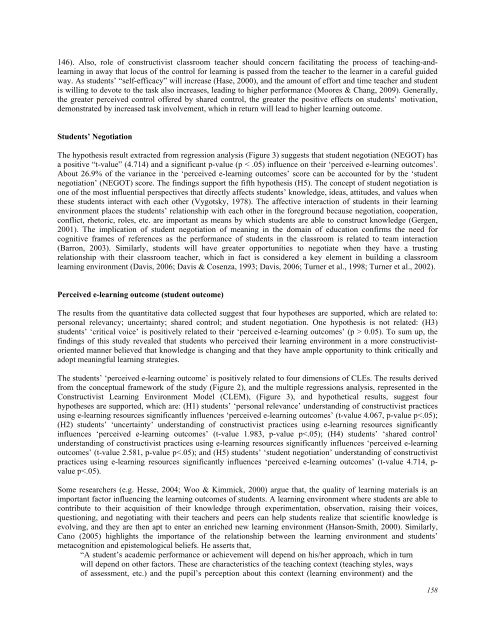October 2011 Volume 14 Number 4 - Educational Technology ...
October 2011 Volume 14 Number 4 - Educational Technology ...
October 2011 Volume 14 Number 4 - Educational Technology ...
Create successful ePaper yourself
Turn your PDF publications into a flip-book with our unique Google optimized e-Paper software.
<strong>14</strong>6). Also, role of constructivist classroom teacher should concern facilitating the process of teaching-andlearning<br />
in away that locus of the control for learning is passed from the teacher to the learner in a careful guided<br />
way. As students’ “self-efficacy” will increase (Hase, 2000), and the amount of effort and time teacher and student<br />
is willing to devote to the task also increases, leading to higher performance (Moores & Chang, 2009). Generally,<br />
the greater perceived control offered by shared control, the greater the positive effects on students’ motivation,<br />
demonstrated by increased task involvement, which in return will lead to higher learning outcome.<br />
Students’ Negotiation<br />
The hypothesis result extracted from regression analysis (Figure 3) suggests that student negotiation (NEGOT) has<br />
a positive “t-value” (4.7<strong>14</strong>) and a significant p-value (p < .05) influence on their ‘perceived e-learning outcomes’.<br />
About 26.9% of the variance in the ‘perceived e-learning outcomes’ score can be accounted for by the ‘student<br />
negotiation’ (NEGOT) score. The findings support the fifth hypothesis (H5). The concept of student negotiation is<br />
one of the most influential perspectives that directly affects students’ knowledge, ideas, attitudes, and values when<br />
these students interact with each other (Vygotsky, 1978). The affective interaction of students in their learning<br />
environment places the students’ relationship with each other in the foreground because negotiation, cooperation,<br />
conflict, rhetoric, roles, etc. are important as means by which students are able to construct knowledge (Gergen,<br />
2001). The implication of student negotiation of meaning in the domain of education confirms the need for<br />
cognitive frames of references as the performance of students in the classroom is related to team interaction<br />
(Barron, 2003). Similarly, students will have greater opportunities to negotiate when they have a trusting<br />
relationship with their classroom teacher, which in fact is considered a key element in building a classroom<br />
learning environment (Davis, 2006; Davis & Cosenza, 1993; Davis, 2006; Turner et al., 1998; Turner et al., 2002).<br />
Perceived e-learning outcome (student outcome)<br />
The results from the quantitative data collected suggest that four hypotheses are supported, which are related to:<br />
personal relevancy; uncertainty; shared control; and student negotiation. One hypothesis is not related: (H3)<br />
students’ ‘critical voice’ is positively related to their ‘perceived e-learning outcomes’ (p > 0.05). To sum up, the<br />
findings of this study revealed that students who perceived their learning environment in a more constructivistoriented<br />
manner believed that knowledge is changing and that they have ample opportunity to think critically and<br />
adopt meaningful learning strategies.<br />
The students’ ‘perceived e-learning outcome’ is positively related to four dimensions of CLEs. The results derived<br />
from the conceptual framework of the study (Figure 2), and the multiple regressions analysis, represented in the<br />
Constructivist Learning Environment Model (CLEM), (Figure 3), and hypothetical results, suggest four<br />
hypotheses are supported, which are: (H1) students’ ‘personal relevance’ understanding of constructivist practices<br />
using e-learning resources significantly influences ‘perceived e-learning outcomes’ (t-value 4.067, p-value p

















